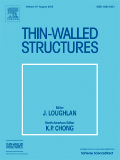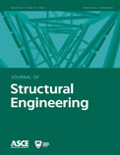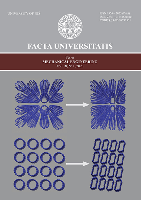
THIN-WALLED STRUCTURES
Scope & Guideline
Pioneering Research in Building and Construction
Introduction
Aims and Scopes
- Thin-walled structures mechanics:
Research on the behavior, stability, and failure mechanisms of thin-walled structures under various loading conditions, including buckling, vibration, and dynamic responses. - Material innovations and composites:
Exploration of new materials, particularly composites and functionally graded materials (FGMs), and their applications in enhancing the performance of thin-walled structures. - Numerical modeling and simulation:
Development and application of advanced numerical methods, including finite element analysis (FEA) and machine learning techniques, for predicting the behavior of thin-walled structures. - Experimental investigations:
Conducting experimental studies to validate theoretical models and numerical simulations, focusing on real-world applications and performance assessments. - Sustainability and resilience:
Emphasis on the design and analysis of structures that are resilient to environmental challenges, including fire resistance, seismic performance, and energy absorption.
Trending and Emerging
- Machine learning applications:
A significant increase in research utilizing machine learning techniques for predictive modeling, optimization, and damage assessment in thin-walled structures, indicating a trend towards data-driven approaches. - Sustainability and eco-friendly designs:
Research focusing on sustainable materials, energy-efficient designs, and resilience to environmental impacts is on the rise, reflecting a broader commitment to sustainability in engineering. - Advanced composite materials:
There is a growing interest in the development and application of advanced composite materials, including bio-inspired designs and auxetic structures, which enhance the mechanical properties and energy absorption capabilities of thin-walled components. - Dynamic and impact analysis:
An emerging focus on the dynamic behavior and impact resistance of thin-walled structures, addressing real-world challenges such as blast loading and seismic events. - Multi-physics modeling:
An increase in publications exploring multi-physics approaches that combine thermal, mechanical, and acoustic analyses to provide a more holistic understanding of thin-walled structures' performance.
Declining or Waning
- Traditional materials and methods:
There is a noticeable decrease in publications focusing solely on conventional materials and traditional construction methods, as the field shifts towards advanced materials and innovative design techniques. - Static analysis in isolation:
Research centered exclusively on static analysis without consideration for dynamic loading conditions or real-world applications is becoming less prominent, as there is a growing demand for comprehensive approaches that account for various loading scenarios. - Basic geometric modeling:
Simplistic geometric modeling approaches are waning in favor of more complex and realistic modeling techniques that incorporate various factors such as imperfections, material properties, and environmental influences.
Similar Journals

International Journal of Steel Structures
Elevating Standards in Steel ConstructionWelcome to the International Journal of Steel Structures, a distinguished publication dedicated to advancing the field of civil and structural engineering since its inception in 2010. Published by the Korean Society of Steel Construction (KSSC), this journal aims to provide a platform for researchers and professionals to share innovative findings and essential insights related to steel structures, emphasizing both theoretical and applied research. With an impact factor that reflects its growing recognition—ranking in Q3 within the civil and structural engineering category—the journal has positioned itself as a significant contributor to the body of knowledge in this vital field. Although currently not an open-access publication, it remains an invaluable resource for students and scholars keen on exploring contemporary challenges and advancements in steel construction. Located in Seoul, South Korea, the journal continues to evolve, converging its presence into the future, with publication efforts spanning through to 2024. Engage with us as we explore the innovative applications and developments in the realm of steel structures.

Magazine of Civil Engineering
Showcasing Excellence in Civil Engineering ScholarshipMagazine of Civil Engineering, published by ST-PETERSBURG STATE POLYTECHNICAL UNIVERSITY, is a prominent open access journal dedicated to the field of civil and structural engineering. With an ISSN of 2712-8172 and E-ISSN 2071-0305, it serves as a vital platform for disseminating high-quality research, innovative methodologies, and current trends in building and construction. Since its inception in 2010, the journal has embraced open access, ensuring broad visibility and accessibility for its contributions to the academic community. The magazine holds a respectable position in the academic hierarchy, ranked in the Q3 quartile for both Building and Construction and Civil and Structural Engineering categories as of 2023. It is indexed in Scopus, amplifying its societal impact and reach with a rank of #114/223 in Building and Construction and #224/379 in Civil and Structural Engineering. Researchers, professionals, and students alike are encouraged to engage with the cutting-edge studies presented in the magazine, contributing to the advancement of knowledge and practice within the civil engineering domain.

International Journal of Structural Integrity
Driving Innovation in Mechanics of MaterialsInternational Journal of Structural Integrity is a premier peer-reviewed academic journal published by EMERALD GROUP PUBLISHING LTD in the United Kingdom. As a valuable resource in the fields of Civil and Structural Engineering, Mechanical Engineering, and Mechanics of Materials, this journal serves to advance knowledge and foster innovation in these critical areas of study. With an impressive impact factor reflected in its 2023 category quartiles, ranking Q2 across multiple engineering disciplines, the journal is recognized for its contributions to research and practical application. Researchers can benefit from its rigorous publishing standards that encompass a wide array of interdisciplinary topics pertaining to structural integrity. Accessing the journal is facilitated for those seeking high-quality research and findings, vital to both academia and industry. Since its inception in 2010 and extending until 2024, the journal continues to attract scholarly articles that push the boundaries of engineering knowledge, making it an essential platform for professionals, students, and researchers seeking to stay at the forefront of structural engineering."

International Journal of Mechanics and Materials in Design
Unveiling Insights in Mechanics and Materials for a Sustainable FutureInternational Journal of Mechanics and Materials in Design is a leading publication in the field of mechanical engineering and materials science, published by Springer Heidelberg. With an impressive impact factor, it holds esteemed rankings as Q1 in both Mechanical Engineering and Mechanics of Materials, and Q2 in Materials Science for the year 2023, solidifying its reputation as a significant contributor to the advancement of design methodologies. The journal focuses on the intersection of mechanics and materials, encouraging innovative research that addresses contemporary challenges faced in engineering disciplines. Researchers and professionals alike can benefit from accessing cutting-edge studies contributing to various applications, making it an invaluable resource for staying informed in this dynamic field. While the journal operates under a subscription model, its comprehensive reviews and high-quality original research foster a deeper understanding of material behavior and design principles, thus supporting the academic growth and professional development of its readers.

JOURNAL OF STRUCTURAL ENGINEERING
Charting New Frontiers in Structural ResearchThe JOURNAL OF STRUCTURAL ENGINEERING, published by the ASCE-AMERICAN SOCIETY OF CIVIL ENGINEERS, is a premier academic journal that focuses on the latest advancements in the field of structural engineering. With a rich history dating back to 1955, this journal has become a crucial platform for disseminating peer-reviewed research that addresses critical issues and innovative solutions in building and construction, civil and structural engineering, materials science, and mechanics. It proudly holds a Q1 quartile ranking across multiple categories in the 2023 Scopus rankings, indicating its influential presence in the academic community. The journal does not currently offer open access options, ensuring that the content is rigorously vetted for quality and relevance, thus appealing to researchers, industry professionals, and students seeking credible, impactful research. With contributions from leading experts, the JOURNAL OF STRUCTURAL ENGINEERING is essential reading for anyone interested in advancing their understanding and practice within this vital area of engineering.

Forces in Mechanics
Connecting Global Minds in Mechanical EngineeringForces in Mechanics is a premier open access journal published by ELSEVIER that has carved out a significant niche in the realms of Mechanical Engineering and Mechanics of Materials. Established in 2020 and based in the Netherlands, this journal aims to disseminate high-quality research that explores the fundamental principles and applications of forces within mechanical systems. It operates under the ISSN 2666-3597, showcasing a dedication to transparent and accessible research for scholars around the globe. With a 2023 impact factor ranking placing it in the Q2 quartile for both Mechanical Engineering and Mechanics of Materials, the journal is recognized for its contributions to the field, evidenced by its Scopus ranking—285th in Mechanical Engineering and 184th in Mechanics of Materials, placing it in the 57th and 53rd percentiles, respectively. The journal publishes original research articles, reviews, and technical notes, catering to a diverse audience including researchers, practitioners, and students who are keen to advance their knowledge on the dynamics of forces in mechanical contexts. As it converges from 2021 to 2024, Forces in Mechanics remains committed to providing a platform for innovative research and critical discourse, ensuring that all published work is freely available to the global community.

ENGINEERING JOURNAL-AMERICAN INSTITUTE OF STEEL CONSTRUCTION
Advancing the Future of Steel Construction.ENGINEERING JOURNAL-AMERICAN INSTITUTE OF STEEL CONSTRUCTION, published by the American Institute of Steel Construction, stands as a vital resource for researchers, practitioners, and students in the fields of Building and Construction as well as Civil and Structural Engineering. With a history tracing back to its convergence in 1968 and an ongoing commitment to advancing engineering knowledge up to 2024, the journal is indexed under the ISSN 0013-8029. Despite its current open access status, the journal carries significant scholarly weight, reflected in its Q3 ranking in both relevant categories for 2023 and Scopus rankings indicating robust academic relevance within its sectors. The publication aims to disseminate innovative research, practical insights, and critical reviews that contribute to the enhancement of steel construction and infrastructure development. Situated in the heart of Chicago, the journal's dedicated focus on steel's pivotal role in engineering design and application forms an essential part of the conversation around modern building practices and sustainability challenges in the construction industry.

STRUCTURAL ENGINEERING AND MECHANICS
Defining the Future of Engineering ResearchSTRUCTURAL ENGINEERING AND MECHANICS, a leading journal published by TECHNO-PRESS, stands at the forefront of research in the disciplines of civil, structural, and mechanical engineering. With an ISSN of 1225-4568 and an E-ISSN of 1598-6217, this South Korea-based journal has been a significant contributor to the academic community since its inception in 1994, and it continues to disseminate vital research through 2024 and beyond. Achieving a Q3 ranking in key categories such as Building and Construction, Civil and Structural Engineering, Mechanical Engineering, and Mechanics of Materials, the journal is recognized for its high standard of academic rigour and relevance in contemporary engineering challenges. Although not Open Access, it offers robust access options for institutions and professionals seeking to advance their understanding of structural systems and mechanics. Researchers, students, and practitioners in these fields will find invaluable insights and innovative studies that push the boundaries of knowledge, making this journal an essential resource for anyone invested in engineering advancements.

Facta Universitatis-Series Mechanical Engineering
Exploring New Frontiers in Mechanical and Structural EngineeringFacta Universitatis-Series Mechanical Engineering is a premier open-access journal published by UNIV NIS, dedicated to advancing knowledge in the fields of mechanical engineering, civil and structural engineering, industrial and manufacturing engineering, mechanics of materials, and polymers and plastics. Since its inception in 1997, this journal has been at the forefront of disseminating high-quality research, boasting an impressive standing in the academic community evidenced by its Q1 rankings in multiple engineering categories for 2023. With its Scopus ranks placing it among the top percentile—97th in Civil and Structural Engineering, 96th in Mechanical Engineering, 95th in Mechanics of Materials, 94th in Industrial and Manufacturing Engineering, and 93rd in Polymers and Plastics—this journal serves as a vital resource for researchers, professionals, and students seeking to engage with the latest developments and innovations in engineering. The journal is committed to supporting the open-access movement, ensuring that cutting-edge research is freely accessible to the global academic community, thus facilitating collaboration and advancement across disciplines.

JOURNAL OF ENGINEERING MECHANICS
Elevating Engineering Standards Through Rigorous ResearchJOURNAL OF ENGINEERING MECHANICS, published by the ASCE - American Society of Civil Engineers, stands as a premier interdisciplinary journal in the field of engineering mechanics. With an impact factor reflecting its vital contributions—placing it in the Q1 category for both Mechanical Engineering and Mechanics of Materials—this journal has established itself as a critical resource for researchers and professionals alike. Since its inception in 1981 and continuing through 2024, it has provided a platform for the dissemination of high-quality research, emphasizing innovative methodologies and cutting-edge findings. The journal's ranking in Scopus further underscores its significance, with impressive standings in the 79th and 77th percentiles of its respective categories. As a vital resource for students and professionals aiming to stay abreast of developments in engineering mechanics, it remains committed to fostering rigorous scientific exploration and practical applications within the field.